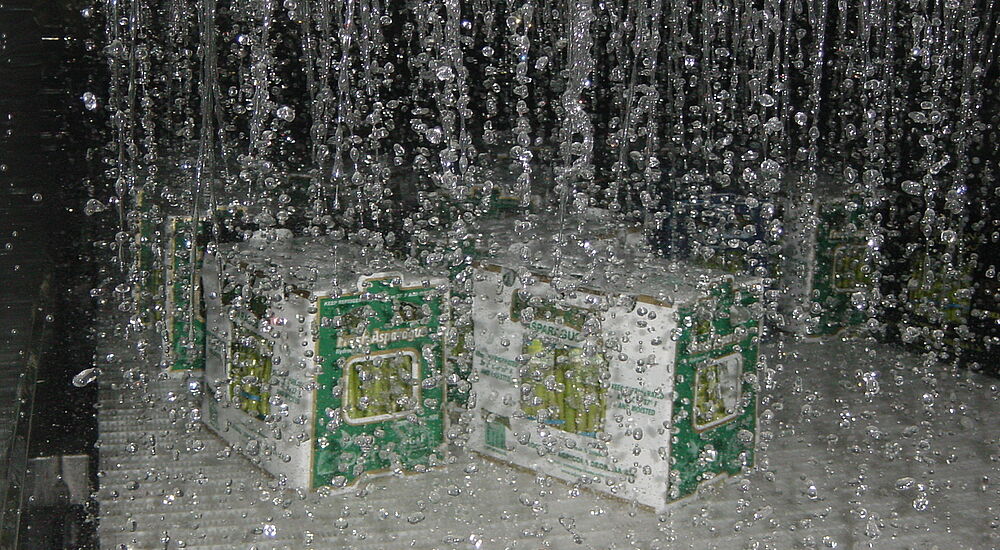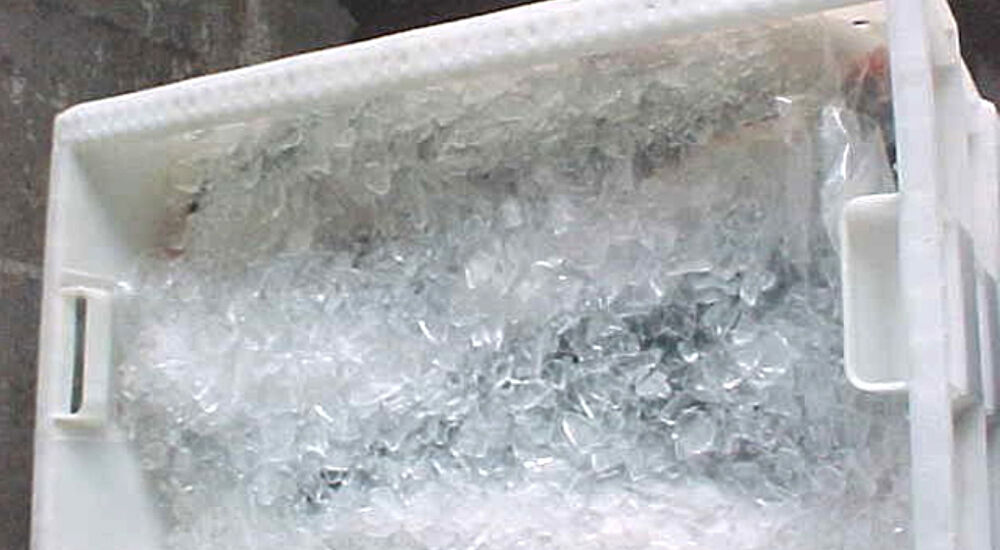
Product cooling
Using ice water or ice
In the food industry, we use chilled mains water (ice water) in addition to water cooling for ice production. This helps to control the temperatures in the production process. By controlling the temperatures, we can keep the growth of microorganisms in check or create a temperature shock. This shock from the cold water with 0.5°C is important for the next steps in food processing.
- Dilution of concentrates in the production of juices, soft drinks, sauces and dressings.
- When making bread, for example, the water is often cooled to bring the dough to the right temperature and thus enable controlled fermentation.
- Mixing dry ingredients with ice water to maintain the right temperature and adjust the consistency when making ice cream, sorbets and pastries. Cooling is also an important step in the preparation of desserts such as mousses or creams in order to achieve the desired consistency and texture.
- Preparation of pharmaceutical products.
- Cooling of perishable products such as soups and broths.
- In the sausage industry to prevent a rise in temperature during the mixing process of ingredients.
- Processing of seafood for cooling or temperature maintenance.
Water cooling close to the freezing point with ice water at 0.5°C is used to keep food cool during production - such as in baking or meat processing. The chilled water helps to regulate the temperature, which in turn controls fermentation processes, limits the growth of microorganisms and ensures food safety.
Cooling techniques are also used to preserve freshness after harvesting. One method is hydrocooling, which helps to preserve the properties of fruit and vegetables during storage and transport.
Fast and effective cooling is essential to ensure the quality and shelf life of seafood. Immediately after being caught, the delicate sea creatures are cooled between ice (crushed ice) to immediately lower the temperature to around 0 °C without losing any time. The ice is not only used to regulate the temperature; it also gently washes the fish as it melts, preserving their natural mucous membranes and the moisture in their skin.
Chip ice is the preferred method for storing fresh fish. The fish is placed on it and kept at a temperature of just below 0 °C. The presence of the ice is of great importance as it inhibits the growth of micro-organisms that would accelerate spoilage and at the same time prevents the fish from drying out. However, it is important that fish is not stored too cold; too low a temperature can lead to freezer burn, which negatively affects the appearance and flavour of the fish. Water pre-cooling or pre-cooling techniques. And the use of industrial ice. Pre-cooling techniques that can be used to quickly remove heat from the product include:
- Cooling with ice water at 0.5°C, also known as hydrocooling, cools products quickly. Cold water draws the heat out of the products and effectively lowers their temperature. This method not only cools quickly, but also increases heat transfer to the product surface, making it very effective. The most important hydrocooling techniques are used for fruit, vegetables, fish, meat, ready meals and sauces.
- In ice cooling, the ice is applied directly under and on top of the product. The most important hydrocooling techniques in the area of application are: fruit, vegetables, fish, meat.
Take the opportunity to experience why hydrocooling cools 15 times faster than air thanks to advanced technology. We guarantee that you will be amazed by the speed, precision and convenience that our state-of-the-art hydrocooling offers for specific types of fruit or vegetables.
Temperature control is crucial for the freshness and shelf life of fruit and vegetables. It controls the respiration processes and the release of ethylene, which can influence and accelerate ripening. By precisely regulating temperatures, it is possible to pick harvested produce in optimum condition and preserve its freshness for longer. This ensures that fruit and vegetables remain juicy, aromatic, with a firm texture and a lower fibre content.
The high heat transfer capacity of ice water at 0.5°C significantly increases the efficiency of the cooling system. It rapidly cools the fruit from 30 to 2 degrees Celsius to reduce respiration activity, extending the storage period and preventing quality loss. This process gives us the flexibility to harvest the fruit exactly when it has reached its optimum flavour characteristics. The cooling time required varies depending on the size and nature of the fruit skin and the amount of cooling water flowing through it.
In addition to the benefits of rapid cooling and reduced respiration, the system also contributes to hygiene. After harvesting, the fruit is washed and disinfected, removing residues of plant protection products, pesticides and harmful micro-organisms such as insects, bacteria or fungi (e.g. Penicillium, Botrytis, Rhyzopus, Alternaria, Monilina). Suspended solids and larger particles such as dust, twigs and leaves, which could affect sales and consumption, are also removed. The result is a high-quality food product for the consumer.
The purpose of cooling with crushed ice is to extend the shelf life of the raw material without fundamentally changing its properties and quality. Depending on the type of food, modern methods of crushed ice production work with a larger contact surface and an ice thickness of 1.5 - 6 mm and a surface area of 2.5 - 5 cm²m. This optimally encloses the product and does not cause any damage to the food that comes into contact with it. During chilling, the temperature of the fish is quickly reduced to a value close to the cryoscopic point (the temperature at which the water in the fish tissue begins to change from a liquid to a solid state). The use of ice lowers the temperature, reduces the biochemical and microbial effects and extends the shelf life of the fish or meat.
Ice in industry must fulfil specific requirements, and this is exactly where BUCO Chip Ice comes in. BUCO ice machines produce precisely the ice you need - be it crushed ice made from salt water or fresh water. The focus is always on optimum cooling performance with the lowest possible energy consumption. The temperature during the production process, whether an ice temperature of -0.5°C or -8°C, only plays a secondary role, as the most effective heat transfer occurs at 0°C with 335 kj/kg. Although supercooled ice (T= -8°C) has a melting capacity that is around 8% higher, this often means double the energy consumption of conventional drum ice machines. BUCO crushed ice, on the other hand, is ideal for cooling purposes as it is particularly gentle on fish. The soft, rounded edges of the ice shards ensure that the sensitive skin of the fish remains unharmed. Due to its ice thickness of 6-8 mm, it melts remarkably slowly, the rinsing off by condensation water allows fewer microorganisms to develop and the quality of the fish is preserved. The quality of the fish surface is not affected by pressure marks or freezer burn. BUCO ice therefore stands for long-lasting freshness and the highest quality of your seafood.

